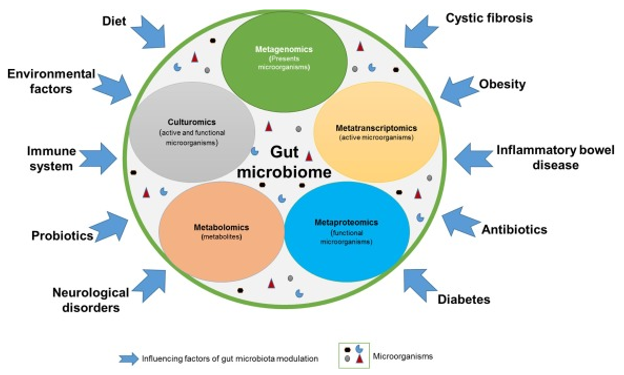The gut microbiota is a diverse population that is central to human fitness and health. A sequence of issues can be caused by gut microbiota dysbiosis. Scientists can look at gut microbiota from a new perspective by doing metaproteomic assessments. Metaproteomics, a topic that relies on all genes and proteins defined from intricate populations, has progressed since it was created in 2004. Metaproteomic research is carried out primarily by 2D-gel electrophoresis techniques back in the initial steps and accompanied by manual mass spectrometry evaluation of single proteins, time-consuming, laborious, and relatively low throughput, one after another. And now, in metaproteomic studies, more sophisticated technologies have been placed into usage and give the potential to handle genotype-phenotype linkages from gut microbiota specimens.
About Our Expressional Proteomics Service
As a prominent company with many years of proteomics knowledge, CD Genomics offers the most feasible mass spectrometry methods to add value to your study of gut metaproteomics. The first is two-dimensional electrophoresis connected with mass spectrometry; the second is chromatography associated with mass spectrometry, also regarded as the shotgun technique. We introduce two paths of metaproteomic research methods. Both techniques include the use of mass spectrometry, which, by assessing the mass to charge ratio (m/z) of proteins, carries out detection as well as composition and structural evaluation.
Expression Proteomics Profiling by LC-MS/MS
Liquid chromatography-mass spectrometry (LC-MS) is an analytical chemistry technique that utilizes liquid chromatography (or HPLC) physical separation capacities with mass spectrometry analysis techniques (MS). In chemical analysis, coupled chromatography - MS systems are important because the specific capacities of each methodology are synergistically improved. While liquid chromatography divides mixtures with various components, mass spectrometry, with high molecular specificity and detection sensitivity, offers the structural identity of the specific components. Liquid chromatography-tandem mass spectrometry (LC-MS/MS) can identify tens of thousands of proteins in a single specimen from bacterial diversity, and amino acid sequences and relative abundance data of identified peptides are also known, enabling expressed protein processes to be characterized within populations and particular matches to be made with microbial lines, with potential subspecies resolution.
Our Advantages
- Higher-order protein structural characteristics such as structures of hydrogen bonding
- Close-to-single-residue resolution and high sequence-coverage comprehensive structural details
- Supplementary structural proteomics methods can produce additional structural and binding data (crosslinking, surface modification, etc.)
Workflow and Bioinformatics Analysis
| Bioinformatics Analysis | Protein Database Searching and Annotation |
| Protein database searching and annotation | To conduct referencing data analysis in both public and commercial databases to ensure the completeness and accuracy of the relation and annotation. Also accessible are de novo searching and homology searching. |
| Quantitative taxonomic analysis | For comparative metaproteomics research, protein quantification is essential. Quantification will mainly show the level of the microbiota from a taxonomic perspective. |
| Data visualization | Gives visualization of different analyses of data, involving but not restricted to taxonomic statuses and mapping of pathways. |
| Functional annotations | To compare the specific proteins in databases and to designate each one a special characteristic. |
| Metabolic pathways linking analysis | The allocation of specific proteins to specific metabolic processes will make it easier to comprehend key cellular signaling and metabolic systems and will reveal the microbiota's biological processes. |
CD Genomics fully capable of discovering the taxonomic and functional components of gut microbial populations that are critical duties in human health, paired with state-of-the-art methods with advanced analytical systems that hold abundant research techniques and advanced pipelines. Consequently, we deliver your gut microbiota studies with thorough and intricate bioinformatics services to give more blessings to our future. Please feel free to reach us in order to know out more about our bioinformatics services to meet your particular needs!
References
1. Isaac NI, Philippe D, Nicholas A, et al. Metaproteomics of the human gut microbiota: challenges and contributions to other OMICS. Clinical Mass Spectrometry. 2019,14.
2. Whiley L, Nye LC, Grant I, et al. Ultrahigh-performance liquid chromatography tandem mass spectrometry with electrospray ionization quantification of tryptophan metabolites and markers of gut health in serum and plasma—Application to clinical and epidemiology cohorts. Analytical chemistry. 2019, 91(8).
3. Lichtman JS, Marcobal A, Sonnenburg JL, Elias JE. Host-centric proteomics of stool: a novel strategy focused on intestinal responses to the gut microbiota. Molecular & Cellular Proteomics. 2013, 12(11).
*For Research Use Only. Not for use in diagnostic procedures.



